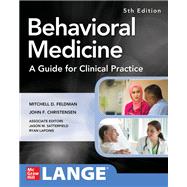SECTION I: THEDOCTOR & PATIENT
Chapter 1: The Medical Interview
Chapter 2: Empathy
Chapter 3: Delivering Serious News
Chapter 4: Difficult Patients/Difficult Situations
Chapter 5: Suggestion & Hypnosis
Chapter 6: Practitioner Well-Being
Chapter 7: Mindful Practice
SECTION II: GLOBALHEALTH
Chapter 8: Global Health and Behavioral Medicine
Chapter 9: Environment, Health, and Behavior
Chapter 10: Training of International Medical Graduates
SECTION III: WORKINGWITH SPECIFIC POPULATIONS
Chapter 11: Families
Chapter 12: Children
Chapter 13: Adolescents
Chapter 14: Older Patients
Chapter 15: Cross-Cultural Communication
Chapter 16: Women
Chapter 17: Lesbian, Gay, Bisexual, Transgender, & QueerPatients
Chapter 18: Vulnerable Patients
SECTION IV: HEALTH-RELATEDBEHAVIOR
Chapter 19: Behavior Change
Chapter 20: Patient Adherence
Chapter 21: Tobacco Use
Chapter 22: Obesity
Chapter 23: Eating Disorders
Chapter 24: Unhealthy Alcohol & Other Substance Use
Chapter 25: Opioids
SECTION V: MENTAL& BEHAVIORAL DISORDERS
Chapter 26: Depression
Chapter 27: Anxiety
Chapter 28: Attention Deficit Hyperactivity Disorder
Chapter 29: Somatic Symptom & Related Disorders
Chapter 30: Personality Disorders
Chapter 31: Psychosis
Chapter 32: Sleep Disorders
Chapter 33: Sexual Problems
Chapter 34: Dementia & Delirium
SECTION VI: SPECIALTOPICS
Chapter 35: Integrative Medicine
Chapter 36: Stress & Disease
Chapter 37: HIV/AIDS
Chapter 38: Pain
Chapter 39: Errors in Medical Practice
Chapter 40: Intimate Partner Violence
Chapter 41: Trauma
Chapter 42: Palliative Care, Hospice, & Care of theDying
SECTION VII: TEACHINGAND ASSESSMENT
Chapter 43: Competency-Based Education for BehavioralMedicine
Chapter 44: Teaching Behavioral Medicine: Theory &Practice
Chapter 45: Assessing Learners & Curricula in theBehavioral & Social Sciences
Chapter 46: Evidence-Based Behavioral Practice
Chapter 47: Narrative Medicine
Chapter 48: Educating for Professionalism
Chapter 49: Trainee Well-Being









